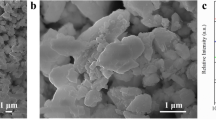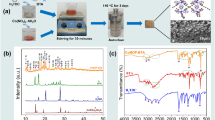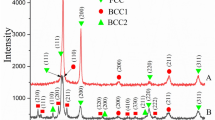The use of compositionally complex ZrO2-based ceramics doped with a mixture of yttrium-subgroup rare-earth metal (REM) oxides for the deposition of thermal barrier coatings (TBCs) was studied. For research, a heavy concentrate (HC) of yttrium-subgroup REM oxides, consisting of (wt.%) 13.3 Y2O3, 1.22 Tb4O7, 33.2 Dy2O3, 8.9 Ho2O3, 21.8 Er2O3, 1.86 Tm2O3, 12.5 Yb2O3, 0.57 Lu2O3, and 6.65 other oxides (including 3.2 Al2O3), and Y2O3 and M-ZrO2 powders were chosen. The targets for depositing electron-beam ceramic TBC layers—both standard and compositionally complex ones—were made of ceramic mixtures including (wt.%) M-ZrO2–7 Y2O3 and 90 M-ZrO2–10 HC. The properties of the compositionally complex and standard yttria-stabilized ZrO2-based ceramic layers in electron-beam TBCs applied in one process cycle were compared. Two-layer metal/ceramic TBCs were deposited onto model blades by directional crystallization from the ZhS-26VI alloy employing an UE-174 industrial electron-beam installation (ELTECHMACH, Vinnytsia). The ceramic M-ZrO2–7 Y2O3 topcoat was denoted as YSZ and 90 M-ZrO2–10 HC as HCSZ. The MZP-6 alloy (nickel–chromium–aluminum–yttrium) was used to form an inner heat-resistant bond coat. This resulted in rough dense glassy coatings differing by color: light-gray YSZ and dark-gray HCSZ. The coatings were 90–95 μm thick on the blade back side and 90 μm thick on the pressure side. Both coatings included the F-ZrO2 phase. Feather-like microstructures emerged in the coatings. The YSZ topcoat contained two types of dense structures, represented by columns and branched formations, and the HCSZ layer was of irregular microstructure with wide feather-like formations growth together. The laminar microstructure of the ceramic topcoat was due to the process features peculiar to electron-beam deposition. The YSZ topcoat had the following microhardness: 3884 MPa on the back side and 6052 MPa on the pressure side. The HCSZ topcoat had much lower microhardness: 1381 MPa on the back side and 1679 MPa on the pressure side. The compositionally complex coating withstood 161 thermal cycles and the standard coating 138 thermal cycles. Previous studies showed that ZrO2 stabilization with concentrates of yttrium-subgroup REM oxides was promising for the microstructural design of TBC ceramic topcoats.




Similar content being viewed by others
References
A. Nandi and S. Ghosh, “Advanced multi-layered thermal barrier coatings—An overview,” J. Mater. Sci. Res. Rev., 2(3), 1–17 (2019), Article No. JMSRR.45533, DOI: https://doi.org/10.9734/JMSRR/2019/45533.
A. Mehta, H. Vasudev, and S. Singh, “Recent developments in the designing of deposition of thermal barrier coatings—A review,” Mater. Today Proc., 26, Part 2, 1336–1342 (2020), https://doi.org/10.1016/j.matpr.2020.02.271.
S.M. Lakiza, M.I. Grechanyuk, O.K. Ruban, V.P. Redko, M.S. Glabay, O.B. Myloserdov, O.V. Dudnik, and S.V. Prokhorenko, “Thermal barrier coatings: current status, search, and analysis,” Powder Metall. Met. Ceram., 57, No. 1–2, 82–113 (2018).
K. Ren, Q. Wang, G. Shao, X. Zhao, and Y. Wang, “Multicomponent high-entropy zirconates with comprehensive properties for advanced thermal barrier coating,” Scr. Mater., 178, No. 15, 382–386 (2020), DOI: https://doi.org/10.1016/j.scriptamat.2019.12.006.
E.V. Dudnik, S.N. Lakiza, I.N. Hrechanyuk, A.K. Ruban, V.P. Redko, I.O. Marek, V.B. Shmibelsky, A.A. Makudera, and N.I. Hrechanyuk, “Thermal barrier coatings based on ZrO2 solid solutions,” Powder Metall. Met. Ceram., 59, No. 3–4, 179–200 (2020).
Yu.A. Tamarin and E.B. Kachanov, “Properties of thermal barrier electron-beam coatings,” in: New Processes and Reliability of Gas Turbine Engines [in Russian], Izd. TsIAM, Moscow (2008), Issue 7, pp. 125–144.
G. Boissonnet, C. Chalk, J.R. Nicholls, G. Bonnet, and F. Pedraza, “Phase stability and thermal insulation of YSZ and erbia-yttria co-doped zirconia EB-PVD thermal barrier coating systems,” Surf. Coat. Technol., 389, 125566 (2020), DOI: https://doi.org/10.1016/j.surfcoat.2020.125566.
Liu Qu and Kwang-Leong Choy, “Thermophisical and thermochemical properties of new thermal barrier materials based on Dy2O3–Y2O3 co-doped zirconia,” Ceram. Int., 40, No. 8, 11593–11599 (2014), DOI: https://doi.org/10.1016/j.ceramint.2014.03.129.
A.U. Munawar, U. Schulz, G. Cerri, and H. Lau, “Microstructure and cyclic lifetime of Gd and Dy-containing EB-PVD TBCs deposited as single and double-layer on various bond coats,” Surf. Coat. Technol., 245, 92–101 (2014), DOI: https://doi.org/10.1016/j.surfcoat.2014.02.047.
Zhang Yanli, Guo Lei, Yang Yongping, Guo Hongbo, Zhang Hongju, and Gong Shengkai, “Influence of Gd2O3 and Yb2O3 Co-doping on phase stability, thermo-physical properties and sintering of 8YSZ,” Chin J. Aeronaut., 25, No. 6, 948–953 (2012), https://doi.org/10.1016/S1000-9361(11)60466-4.
Lei Guo, Mingzhu Li, and Fuxing Ye, “Phase stability and thermal conductivity of RE2O3 (RE — La, Nd, Gd, Yb) and Yb2O3 co-doped Y2O3 stabilized ZrO2 ceramics,” Ceram. Int., 42, No. 6, 7360–7365 (2016), https://doi.org/10.1016/j.ceramint.2016.01.138.
G. Lei, Z. Chenglong, L. Mingzhu, S. Wei, Z. Zhaoyang, and Y. Fuxing, “Hot corrosion evaluation of Gd2O3–Yb2O3 co-doped Y2O3 stabilized ZrO2 thermal barrier oxides exposed to Na2SO4 + V2O5 molten salt,” Ceram. Int., 43, No. 2, 2780–2785 (2017), https://doi.org/10.1016/j.ceramint.2016.11.109.
S. Zhou, S. Shen, X. Fang, Q. Hou, and D. Zhao, “An accurate and rapid method to compare thermal insulation capacity of nine Gd–Yb–YSZ coatings,” Ceram. Int., 45, No. 16, 19910–19917 (2019), https://doi.org/10.1016/j.ceramint.2019.06.247.
D.M. Zhu and R.A. Miller, “Development of advanced low conductivity thermal barrier coatings,” Int. J. Appl. Ceram. Technol., 1, No. 1, 86–94 (2004), DOI: https://doi.org/10.1111/j.1744-7402.2004.tb00158.x.
M.J. Kelly, D.E. Wolfe, J. Singh, J. Eldridge, D. Zhu, and R. Miller, “Thermal barrier coatings design with increased reflectivity and lower thermal conductivity for high-temperature turbine applications,” Int. J. Appl. Ceram. Technol., 3, No. 2, 81−93 (2006), DOI: https://doi.org/10.1111/j.1744-7402.2006.02073.x.
Leilei Sun, Hongbo Guon, Hui Peng, Shengkai Gong, and Huibin Xu, “Phase stability and thermal conductivity of ytterbia and yttria co-doped zirconia,” Prog. Nat. Sci. Mater. Int., 23, No. 4, 440–445 (2013), https://doi.org/10.1016/j.pnsc.2013.06.013.
C.M. Rost, E. Sachet, T. Borman, A. Moballegh, E.C. Dickey, D. Hou, J.L. Jones, S. Curtarolo, and J.-P. Maria, “Entropy-stabilized oxides,” Nat. Commun., 6, 8485 (2015), DOI: https://doi.org/10.1038/ncomms9485.
Brianna L. Musicó, Dustin Gilbert, Thomas Zac Ward, Katharine Page, Easo George, Jiaqiang Yan, David Mandrus, and Veerle Keppens, “The emergent field of high entropy oxides: Design, prospects, challenges, and opportunities for tailoring material properties,” APL Mater., 8, No. 4 (2020), DOI: https://doi.org/10.1063/5.0003149.
Heng Chenab, Huimin Xiang, Fu-Zhi Dai Jiachen, Liu, and Yanchun Zhou, “High entropy (Yb0.25Y0.25Lu0.25Er0.25)2SiO5 with strong anisotropy in thermal expansion,” J. Mater. Sci. Technol., 36, 134–139 (2020), DOI: 10.1016/j.jmst.2019.07.022.
Z. Zhao, H. Chen, H. Xiang, F.-Zhi Dai, X. Wang, W. Xu, K. Sun, Z. Peng, and Y. Zhou, “High-entropy (Y0.2Nd0.2Sm0.2Eu0.2Er0.2)AlO3: A promising thermal/environmental barrier material for oxide/oxide composites,” J. Mater. Sci. Technol., 47, 45–51 (2020), DOI: 10.1016/j.jmst.2020.02.011.
Z. Zhao, H. Chen, H. Xiang, F.-Zhi Dai, X. Wang, W. Xu, K. Sun, Z. Peng, and Y. Zhou, “(Y0.25Yb0.25Er0.25Lu0.25)2(Zr0.5Hf0.5)2O7: A defective fluorite structured high entropy ceramic with low thermal conductivity and close thermal expansion coefficient to Al2O3,” J. Mater. Sci. Technol., 39, 167–171 (2019), DOI: https://doi.org/10.1016/j.jmst.2019.08.018.
L. Sun, Y. Luo, Z. Tian, T. Du, X. Ren, J. Li, W. Hu, J. Zhang, and J. Wang, “High temperature corrosion of (Er0.25Tm0.25Yb0.25Lu0.25)2Si2O7 environmental barrier coating material subjected to water vapor and molten calcium–magnesium–aluminosilicate (CMAS),” Corros Sci., 175 (2020), DOI: https://doi.org/10.1016/j.corsci.2020.108881.
Heng Chen, Zifan Zhao, Huimin Xiang, Fu-Zhi Dai, Wei Xu, Kuang Sun, Jiachen Liu, and Yanchun Zhou, “High entropy (Y0.2Yb0.2Lu0.2Eu0.2Er0.2)3Al5O12: a novel high temperature stable thermal barrier material,” J. Mater. Sci. Technol., No. 13, 57–62 (2020), DOI: https://doi.org/10.1016/j.jmst.2020.01.056.
A.J. Wright, Q. Wang, Ch. Huang, A. Nieto, R. Chen, and J. Luo, “From high-entropy ceramics to compositionally-complex ceramics: A case study of fluorite oxides,” J. Eur. Ceram. Soc., 40, No. 5, 1791–2252 (2020), DOI: https://doi.org/10.1016/j.jeurceramsoc.2020.01.015.
Andrew J. Wright, Qingyang Wang, Shu-Ting Ko, Ka Man Chung, Renkun Chen, and Jian Luo, “Size disorder as a descriptor for predicting reduced thermal conductivity in medium- and high-entropy pyrochlore oxides,” Scr. Mater., 181, 76–81 (2020), DOI: https://doi.org/10.1016/j.scriptamat.2020.02.011.
Andrew J. Wrighta and Jian Luoa, “A step forward from high-entropy ceramics to compositionally complex ceramics: a new perspective,” J. Mater. Sci., 55, No. 23, 9812–9827 (2020), DOI: https://doi.org/10.1007/s10853-020-04583-w.
V.A. Mikhailov, World Rare Earth Ores: Geology, Resources, Economics: Monograph [in Russian], Kyivskii Universitet, Kyiv (2010), p. 223.
B.A. Movchan and I.S. Malashenko, High-Temperature Oxidation-Resistant Coatings Deposited in Vacuum [in Russian], Naukova Dumka, Kyiv (1983), p. 230.
N.I. Grechanyuk, “Modern electron-beam techniques of producing new materials and coatings (review),” Visn. Ukr. Materialoznav. Tov., No. 1(3), 7–15 (2010).
Materials in Ingots and Powders for Protective Coatings [in Russian], Amendment No. 3 to Technical Specifications, U 27.4-201134.10.002–2001 dated September 3 (2015).
Quality Control of Electron-Beam Coatings [in Russian], TU 7541318.77.0061, ZMKB Progres Akad. Ivchenka, Zaporizhzhya (2011), p. 12.
N.I. Grechanyuk, V.A. Osokin, and P.A. Shpak, “Effect of production parameters on the structure of the outer ceramic layer in two-layer metal–ceramic coatings prepared by electron-beam deposition in one production cycle,” Powder Metall. Met. Ceram., 44, No. 3–4, 137–142 (2005).
P.A. Shpak, N.I. Grechanyuk, V.A. Osokin, and E.L. Piyuk, “Two-layer metal–ceramic thermal coatings applied by electron-beam vapor deposition in one process,” Powder Metall. Met. Ceram., 46, No. 7–8, 392–397 (2007).
U. Schulz, B. Saruhan, K. Fritscher, and Ch. Leyens, “Review on advanced EB-PVD ceramic topcoats for TBC applications,” Int. J. Appl. Ceram. Technol., 1, No. 4, 302–315 (2004).
K.Yu. Yakovchuk, Yu.E. Rudoy, L.M. Nerodenko, E.V. Onoprienko, and A.O. Akhtyrskii, “Effect of substrate surface curvature on the structure and properties of thermal barrier condensation coatings,” Sovr. Elektrometall., No. 1, 22–29 (2011).
Author information
Authors and Affiliations
Corresponding author
Additional information
Translated from Poroshkova Metallurgiya, Vol. 59, Nos. 11–12 (536), pp. 73–84, 2020.
Rights and permissions
About this article
Cite this article
Dudnik, O., Lakiza, S., Grechanyuk, I. et al. Composite Ceramics for Thermal Barrier Coatings Produced From ZrO2 Doped with Yttrium-Subgroup Rare-Earth Metal Oxides. Powder Metall Met Ceram 59, 672–680 (2021). https://doi.org/10.1007/s11106-021-00202-8
Received:
Published:
Issue Date:
DOI: https://doi.org/10.1007/s11106-021-00202-8




